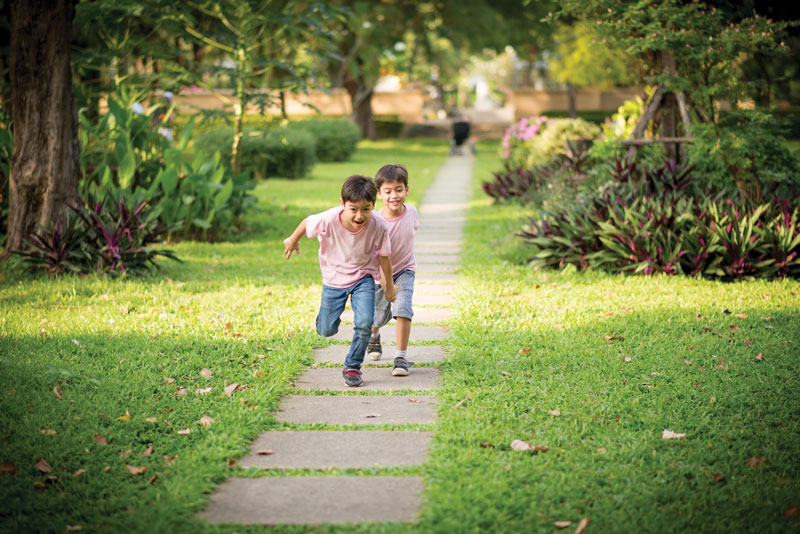Adults frequently say, “Go play outside,” to their children without fully realizing the benefits that can come from outdoor play and getting dirty. Digging into dirt can have significant physical health benefits. Exposure to a range of bacteria is essential to human health and building up immunity, especially in children. Luckily there’s a fast-track solution for anyone seeking to get out of hyper-sanitized environments: soil! A single teaspoon of rich garden soil contains more than 1 billion bacteria. Let them dig. They might get messy and dirty, and the bathwater at the end of the day might turn brown. But their little bodies will be that much more dynamic with exposure to microbes.
Practicing mindfulness can spur mental benefits akin to practicing meditation. An easy place to take a moment and notice your surroundings with fresh eyes lies out your front door. The natural world – from varying weather patterns, to different seasons, to insects and small creatures – offers an endless canvas of opportunities to observe. In turn, the act of putting your full attention towards something, or being mindful, is linked to reducing anxiety and improving cognition.
Here are some concrete ideas for encouraging more outdoor play. I’ve listed them in a crescendo of age-appropriate activities based on experiences with my two-year-old and the older neighborhood children. Some can be done in a moment; others will play out over time.
• LOOK: Pick up a big rock and look underneath for bugs. Watch as they curl up in fright, and then slowly relax as they feel safe. Marvel at their antennae and imagine the information they are receiving. Touch the slimy snails, hold the wriggling worms, and let the last ladybug of the season climb to the tip of your finger, and fly. Wonder at their worlds.
• SPLASH: Don your rain boots and stomp in rain puddles. Bend down and watch closely as the raindrops hit the surface of the water. Look up and feel each drop hit your skin.
• COUNT: Be still and count how many insects and animals you see.
• PLAY: Romp. Roll. Tumble. Try a cartwheel. Use your body to move, hop over rocks.
• DIG: Dig holes. As a bonus, plant some bulbs. The fall is the unsung gardening hero season to put little goodies in the ground that will delight come spring.
• CREATE ART: As a corollary to planting bulbs, make a map of your property and mark and color in where you’ve planted the bulbs with the appropriate colors. Come spring, watch as these bulbs come up and compare with the map. Talk about the temperature of the soil, and how these flowers are like thermometers for the soil “popping” up as the earth warms up. Remember to put a “north” arrow on your map.
• EXPERIMENT: Put a ½”-layer of compost on half of your lawn (or mark out a section of it with some string). Rake it out and add water, letting the compost settle into the soil. After a few weeks, compare the grass in areas with compost with non-amended grass. How does the ground feel (harder or softer)? How does the color compare (darker or lighter green)? What other differences do you notice?
• ADD COMPOST: If you don’t want to subject your lawn to a science experiment (see “EXPERIMENT” above) and would prefer to add compost to the whole area, go for it. Take this as an opportunity to do a real-world math problem with your child that involves measuring, converting inches to feet, calculating the total volume, and then dividing by 27 to figure out how many cubic yards are needed (there are 27 cubic feet in a cubic yard, and bulk compost is sold by the cubic yard). If you need guidance on these calculations, head over to: http://www.harvestpower.com/how-much-soil-mulch-needed/
• SPREAD MULCH: Mulch is like a magic carpet. It looks great right away. Over the long term, it helps suppress weeds, keeps temperatures steady, and slowly releases nutrients into the soil as the mulch breaks down. Plus shoveling and spreading mulch is a great workout: shoveling mulch burns between 300-430 calories per hour depending on the pace. Note: for best results, remove weeds beforehand, then add a 1”-2” layer of mulch. Come spring you’ll just need a touchup layer.
• UNPLUG: Let outdoor work and play be a “phone free” time. If you can, leave your phone inside and let that space be spent truly paying attention to nature, your kids, and your local environment. Those text messages and emails and social media posts can wait an hour. Bonus: During your time away from it, notice how frequently your hand involuntarily reaches for your device.
Connecticut residents have an additional unseen benefit when romping and rolling on public grassy areas: almost 20 years ago Connecticut’s legislature passed a law (P.A. 09-56) banning lawn care pesticide applications on the grounds of day care centers, elementary and middle schools. In addition, many homeowners are trending towards natural lawn care practices, such as overseeding, aeration, adjusting mowing heights, and adding yearly topdressings of compost. It’s nice to feel safe and green on grass.
Next time you say, “Go outside and play,” you can be more concrete about digging in and getting dirty. And you can be confident that their little bodies and brains are benefiting from outdoor play.
Meredith Sorensen is the Director of Communication for Harvest, a company creating a more sustainable future by turning organic materials into locally consumed products that are good for the environment. Harvest New England provides top quality soils, mulches and custom blends in Connecticut in our Fairfield, Farmington, Ellington, and Wallingford locations, and can be found at: http://www.harvestpower.com/ne
